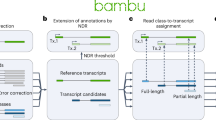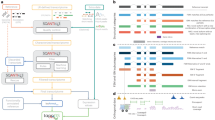Abstract
With the increasing number of whole genome sequences available, genomic research has shifted toward the annotation of functional elements and transcribed regions. Thus, the related field of transcriptome research requires accurate methods for the profiling of genes that are not biased by known sequence information, and that also allow for the identification of promoter regions. Starting with serial analysis of gene expression (SAGE), methods making use of short sequencing tags have greatly contributed to transcriptome studies. Here we review recent developments in the use of short sequencing tags in expression profiling, gene discovery and genome annotation. These tags are obtained from the 5′ end of mRNAs, both terminal ends of mRNAs, or genomic regions. The 5′ end–specific tags, with their ability to identify transcripts along with their transcriptional start sites, will be of particular interest for gene network studies and may become one of the most important approaches in systems biology.
This is a preview of subscription content, access via your institution
Access options
Subscribe to this journal
Receive 12 print issues and online access
$259.00 per year
only $21.58 per issue
Buy this article
- Purchase on Springer Link
- Instant access to full article PDF
Prices may be subject to local taxes which are calculated during checkout




Similar content being viewed by others
References
Ruan, Y., Le Ber, P., Ng, H.H. & Liu, E.T. Interrogating the transcriptome. Trends Biotechnol. 22, 23–30 (2004).
Gerhard, D.S. et al. The status, quality, and expansion of the NIH full-length cDNA project: the Mammalian Gene Collection (MGC). Genome Res. 14, 2121–2127 (2004).
Okazaki, Y. et al. Analysis of the mouse transcriptome based on functional annotation of 60,770 full-length cDNAs. Nature 420, 563–573 (2002).
Landry, J.R., Mager, D.L. & Wilhelm, B.T. Complex controls: the role of alternative promoters in mammalian genomes. Trends Genet. 19, 640–648 (2003).
Black, D.L. Mechanisms of alternative pre-messenger RNA splicing. Annu. Rev. Biochem. 72, 291–336 (2003).
Garcia-Blanco, M.A., Baraniak, A.P. & Lasda, E.L. Alternative splicing in disease and therapy. Nat. Biotechnol. 22, 535–546 (2004).
Brasch, M.A., Hartley, J.L. & Vidal, M. ORFeome cloning and systems biology: standardized mass production of the parts from the parts-list. Genome Res. 14, 2001–2009 (2004).
Marshall, E. Getting the noise out of gene arrays. Science 306, 630–631 (2004).
Tan, P.K. et al. Evaluation of gene expression measurements from commercial microarray platforms. Nucleic Acids Res. 31, 5676–5684 (2003).
Bertone, P. et al. Global identification of human transcribed sequences with genome tiling arrays. Science 306, 2242–2246 (2004).
Kampa, D. et al. Novel RNAs identified from an in-depth analysis of the transcriptome of human chromosomes 21 and 22. Genome Res. 14, 331–342 (2004).
Cheng, J. et al. Transcriptional maps of 10 human chromosomes at 5-nucleotide resolution. Science 308, 1149–1154 (2005).
Velculescu, V.E., Zhang, L., Vogelstein, B. & Kinzler, K.W. Serial analysis of gene expression. Science 270, 484–487 (1995).
Brenner, S. et al. Gene expression analysis by massively parallel signature sequencing (MPSS) on microbead arrays. Nat. Biotechnol. 18, 630–634 (2000).
Saha, S. et al. Using the transcriptome to annotate the genome. Nat. Biotechnol. 20, 508–512 (2002).
Matsumura, H. et al. SuperSAGE. Cell. Microbiol. 7, 11–18 (2005).
Matsumura, H. et al. Gene expression analysis of plant host-pathogen interactions by SuperSAGE. Proc. Natl. Acad. Sci. USA 100, 15718–15723 (2003).
Powell, J. SAGE. The serial analysis of gene expression. Methods Mol. Biol. 99, 297–319 (2000).
Wang, S.M. SAGE: Current Technologies an Applications. (Horizon Bioscience, Norwich; 2005).
Lash, A.E. et al. SAGEmap: a public gene expression resource. Genome Res. 10, 1051–1060 (2000).
Man, M.Z., Wang, X. & Wang, Y. POWER_SAGE: comparing statistical tests for SAGE experiments. Bioinformatics 16, 953–959 (2000).
Wang, D.G. et al. Large-scale identification, mapping, and genotyping of single-nucleotide polymorphisms in the human genome. Science 280, 1077–1082 (1998).
Sachidanandam, R. et al. A map of human genome sequence variation containing 1.42 million single nucleotide polymorphisms. Nature 409, 928–933 (2001).
Silva, A.P. et al. The impact of SNPs on the interpretation of SAGE and MPSS experimental data. Nucleic Acids Res. 32, 6104–6110 (2004).
Shiraki, T. et al. Cap analysis gene expression for high-throughput analysis of transcriptional starting point and identification of promoter usage. Proc. Natl. Acad. Sci. USA 100, 15776–15781 (2003).
Hwang, B.J., Muller, H.M. & Sternberg, P.W. Genome annotation by high-throughput 5′ RNA end determination. Proc. Natl. Acad. Sci. USA 101, 1650–1655 (2004).
Hashimoto, S. et al. 5′-end SAGE for the analysis of transcriptional start sites. Nat. Biotechnol. 22, 1146–1149 (2004).
Wei, C.L. et al. 5′ long serial analysis of gene expression (LongSAGE) and 3′ LongSAGE for transcriptome characterization and genome annotation. Proc. Natl. Acad. Sci. USA 101, 11701–11706 (2004).
Schnoor, M. et al. Characterization of the synthetic compatible solute homoectoine as a potent PCR enhancer. Biochem. Biophys. Res. Commun. 322, 867–872 (2004).
Das, M., Harvey, I., Chu, L.L., Sinha, M. & Pelletier, J. Full-length cDNAs: more than just reaching the ends. Physiol. Genomics 6, 57–80 (2001).
Sugahara, Y. et al. Comparative evaluation of 5′-end-sequence quality of clones in CAP trapper and other full-length cDNA libraries. Gene 263, 93–102 (2001).
Altschul, S.F. et al. Gapped BLAST and PSI-BLAST: a new generation of protein database search programs. Nucleic Acids Res. 25, 3389–3402 (1997).
Kasai, Y. et al. 5′ SAGE: 5′-end Serial Analysis of Gene Expression database. Nucleic Acids Res. 33, D550–D552 (2005).
Tateno, Y., Saitou, N., Okubo, K., Sugawara, H. & Gojobori, T. DDBJ in collaboration with mass-sequencing teams on annotation. Nucleic Acids Res. 33, D25–D28 (2005).
Harbers, M. & Carninci, P. in SAGE: Current Technologies and Applications. (ed. S.M. Wang) 29–76 (Horizon Bioscience, Norwich; 2005).
Hieronymus, H. & Silver, P.A. A systems view of mRNP biology. Genes Dev. 18, 2845–2860 (2004).
Ideker, T., Galitski, T. & Hood, L. A new approach to decoding life: systems biology. Annu. Rev. Genomics Hum. Genet. 2, 343–372 (2001).
Laub, M.T., McAdams, H.H., Feldblyum, T., Fraser, C.M. & Shapiro, L. Global analysis of the genetic network controlling a bacterial cell cycle. Science 290, 2144–2148 (2000).
Ideker, T. et al. Integrated genomic and proteomic analyses of a systematically perturbed metabolic network. Science 292, 929–934 (2001).
Lee, T.I. et al. Transcriptional regulatory networks in Saccharomyces cerevisiae. Science 298, 799–804 (2002).
Edgar, R., Domrachev, M. & Lash, A.E. Gene Expression Omnibus: NCBI gene expression and hybridization array data repository. Nucleic Acids Res. 30, 207–210 (2002).
Kodzius, R. et al. Absolute expression values for mouse transcripts: re-annotation of the READ expression database by the use of CAGE and EST sequence tags. FEBS Lett. 559, 22–26 (2004).
Carninci, P. et al. Targeting a complex transcriptome: the construction of the mouse full-length cDNA encyclopedia. Genome Res. 13, 1273–1289 (2003).
Scheetz, T.E. et al. High-throughput gene discovery in the rat. Genome Res. 14, 733–741 (2004).
Pleasance, E.D., Marra, M.A. & Jones, S.J. Assessment of SAGE in transcript identification. Genome Res. 13, 1203–1215 (2003).
Ng, P. et al. Gene identification signature (GIS) analysis for transcriptome characterization and genome annotation. Nat. Methods 2, 105–111 (2005).
Macevicz, S.C. US patent 6, 136,537 (2000).
Salditt-Georgieff, M., Harpold, M.M., Wilson, M.C. & Darnell, J.E., Jr. Large heterogeneous nuclear ribonucleic acid has three times as many 5′ caps as polyadenylic acid segments, and most caps do not enter polyribosomes. Mol. Cell. Biol. 1, 179–187 (1981).
Carninci, P. et al. Normalization and subtraction of cap-trapper-selected cDNAs to prepare full-length cDNA libraries for rapid discovery of new genes. Genome Res. 10, 1617–1630 (2000).
Wang, T.L. et al. Digital karyotyping. Proc. Natl. Acad. Sci. USA 99, 16156–16161 (2002).
Sabo, P.J. et al. Discovery of functional noncoding elements by digital analysis of chromatin structure. Proc. Natl. Acad. Sci. USA 101, 16837–16842 (2004).
Kim, J., Bhinge, A.A., Morgan, X.C. & Iyer, V.R. Mapping DNA-protein interactions in large genomes by sequence tag analysis of genomic enrichment. Nat. Methods 2, 47–53 (2004).
Shibata, Y. et al. Removal of polyA tails from full-length cDNA libraries for high-efficiency sequencing. Biotechniques 31, 1042, 1044, 1048–1049 (2001).
Carninci, P. & Hayashizaki, Y. High-efficiency full-length cDNA cloning. Methods Enzymol. 303, 19–44 (1999).
Carninci, P. et al. High-efficiency full-length cDNA cloning by biotinylated CAP trapper. Genomics 37, 327–336 (1996).
Maruyama, K. & Sugano, S. Oligo-capping: a simple method to replace the cap structure of eukaryotic mRNAs with oligoribonucleotides. Gene 138, 171–174 (1994).
Edery, I., Chu, L.L., Sonenberg, N. & Pelletier, J. An efficient strategy to isolate full-length cDNAs based on an mRNA cap retention procedure (CAPture). Mol. Cell. Biol. 15, 3363–3371 (1995).
Theissen, H. et al. Cloning of the human cDNA for the U1 RNA-associated 70K protein. EMBO J. 5, 3209–3217 (1986).
Merenkova, I., Milne, E. & Jean-Baptiste, D. US patent 6, 136,537 (2000).
Acknowledgements
We thank Y. Hayashizaki and T. Hayashi for their support and encouragement in the development and application of CAGE and GSC, and the entire RIKEN GSL and GSC as well as Dnaform teams, who helped to make the CAGE and GSC projects possible. In particular we are grateful to T. Shiraki, R. Kodzius, H. Nishiyori, M. Nakamura, Y. Kojima, H. Sato, T. Kawazu, K. Waki, S. Fukuda, S. Katayama and A. Hasegawa for their contribution to CAGE-related projects, and to Y. Shibata, S. Takaku and M. Suzuki for their contribution to GSC development. We also thank Y. Ruan for fruitful discussions and our collaboration within the FANTOM 3 project, and M. Dushay for critically reading the manuscript.
Author information
Authors and Affiliations
Corresponding authors
Ethics declarations
Competing interests
M.H. is an employee of the company K.K. Dnaform.
Rights and permissions
About this article
Cite this article
Harbers, M., Carninci, P. Tag-based approaches for transcriptome research and genome annotation. Nat Methods 2, 495–502 (2005). https://doi.org/10.1038/nmeth768
Issue Date:
DOI: https://doi.org/10.1038/nmeth768
This article is cited by
-
De novo assembly of transcriptome from next‐generation sequencing data
Quantitative Biology (2016)



